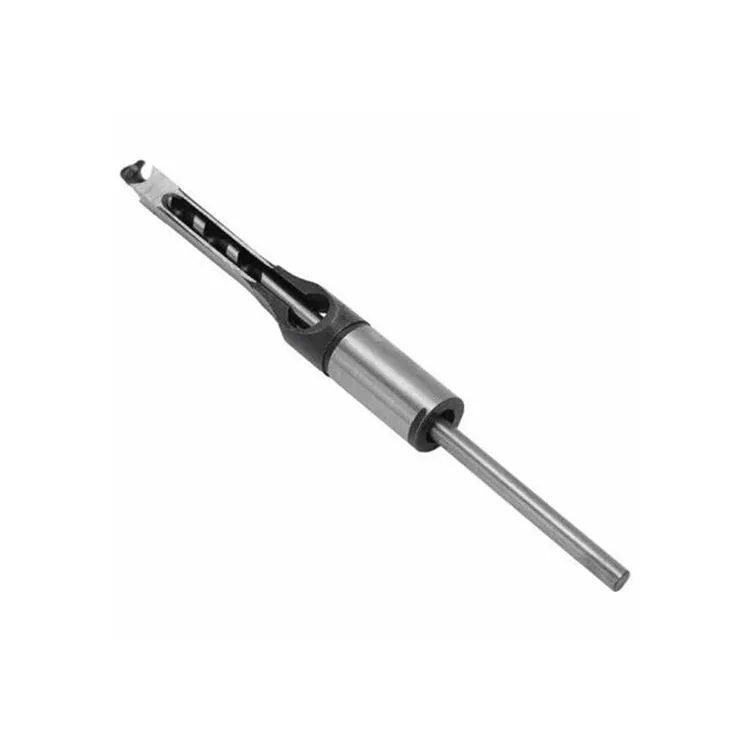The Mortise Drill Bit: Precision Tool for Perfect Woodworking Joints
2024-09-09
In the world of woodworking, precision and quality are key to crafting strong, beautiful projects. One tool that every serious woodworker should have in their toolkit is the mortise drill bit. This specialized tool makes it easy to create accurate, clean mortises – rectangular holes that are essential for constructing mortise-and-tenon joints, one of the most traditional and robust woodworking techniques. Whether you're building furniture, cabinetry, or architectural elements, the mortise drill bit is indispensable for achieving professional-grade results.
What is a Mortise Drill Bit?
A mortise drill bit, also known as a hollow chisel mortiser, is a specialized bit designed to drill square or rectangular holes, usually for mortise-and-tenon joints. The mortise bit combines a standard drill bit housed inside a hollow chisel. The drill bit bores the hole while the chisel squares off the sides, leaving behind a clean, precise mortise.
Mortise drill bits are often used with mortising machines, but they can also be used with specialized attachments on drill presses. The result is a smooth, square-edged hole that can then accept the tenon (the matching rectangular projection) in woodworking joinery.
Why Use a Mortise Drill Bit?
Mortise-and-tenon joints are known for their strength and durability. However, hand-cutting mortises can be time-consuming and require a lot of skill. The mortise drill bit takes the hard work out of the process by automating it, allowing woodworkers to create uniform, precise joints quickly and efficiently. Here are some key reasons to use a mortise drill bit:
1. Efficiency and Speed
Using a mortise drill bit allows you to cut mortises much faster than doing it by hand. The combined action of drilling and chiseling in one step speeds up the process and produces consistent results, saving time on large projects.
2. Accuracy
A mortise drill bit ensures that the mortise you cut is perfectly square, making it easier to fit the tenon into place. Achieving this level of precision by hand can be difficult, especially when working with harder woods. With a mortising machine or a drill press attachment, the bit maintains the correct angle and depth, ensuring professional-quality joints every time.
3. Consistent Mortises
When creating multiple joints, consistency is crucial. A mortise drill bit ensures that all of your mortises are the same size and shape, making the assembly of your project smoother and more precise. Uniform mortises mean that your joints will fit tightly, leading to stronger connections in your final product.
4. Versatility
Mortise drill bits come in a variety of sizes, allowing you to create mortises of different widths and depths depending on the requirements of your project. From fine cabinetry work to heavy-duty furniture construction, these bits offer the flexibility needed for a wide range of applications.
Types of Mortise Drill Bits
There are several types of mortise drill bits available, each designed for specific applications and materials. Here’s a quick look at the most common types:
1. Standard Mortise Drill Bits
These are the most common mortise bits and are used for general-purpose woodworking. They can be used with most mortising machines and drill press attachments to create clean, square mortises in various types of wood.
2. Heavy-Duty Mortise Drill Bits
For projects that require cutting mortises in harder woods or when working on large-scale furniture or structural elements, heavy-duty mortise bits are designed for durability and longevity. These bits are built to withstand higher levels of stress and can handle denser materials without dulling quickly.
3. Adjustable Mortise Drill Bits
Some mortise drill bits come with adjustable chisels, allowing you to modify the width of the mortise. These are particularly useful for custom projects where you need different-sized joints throughout.
How to Use a Mortise Drill Bit
Using a mortise drill bit requires a bit of preparation, but once set up, it’s a straightforward process. Here’s how to get started:
1. Choose the Right Mortise Drill Bit
Select the appropriate size for your project. The bit should match the width of the tenon that will fit into the mortise. Make sure the bit is sharp and free of debris for clean cutting.
2. Install the Bit in a Mortising Machine or Drill Press
Mortise drill bits are typically used with mortising machines or drill presses that have specialized attachments. Ensure that the bit is securely fastened and that the machine is set to the correct depth for the mortise you’re cutting.
3. Mark the Mortise on the Wood
Before drilling, mark the location and size of the mortise on the wood. This ensures that you cut in the correct place and helps maintain accuracy.
4. Drill the Mortise
Turn on the machine and carefully guide the bit into the wood, allowing the drill bit to bore through while the chisel squares the hole’s edges. Work slowly and methodically to avoid mistakes.
5. Test Fit the Tenon
Once the mortise is cut, test fit the tenon to ensure it fits snugly. If necessary, make small adjustments by sanding or using a chisel to fine-tune the fit.
Tips for Using a Mortise Drill Bit
- Sharpen your bit regularly: A dull mortise drill bit will not only slow down your work but may also produce uneven mortises. Keep both the drill bit and the chisel sharpened for best results.
- Choose the right speed: When using a drill press, ensure that you set the machine to the correct speed for the wood you’re working with. Hardwoods typically require slower speeds, while softer woods can be drilled at higher speeds.
- Clear out wood chips frequently: During drilling, wood chips can accumulate and cause the bit to overheat. Stop periodically to clear out debris to maintain clean cuts and prolong the life of the bit.
Conclusion
The mortise drill bit is a crucial tool for woodworkers looking to improve their efficiency and precision when creating mortise-and-tenon joints. Its ability to drill and chisel simultaneously results in clean, accurate mortises that are essential for strong and aesthetically pleasing joints. Whether you're building fine furniture, cabinetry, or other wood projects, investing in a quality mortise drill bit can take your craftsmanship to the next level.
By understanding how to choose and use the right mortise drill bit for your needs, you can achieve professional results and enjoy the satisfaction of crafting durable, beautiful woodworking joints.



